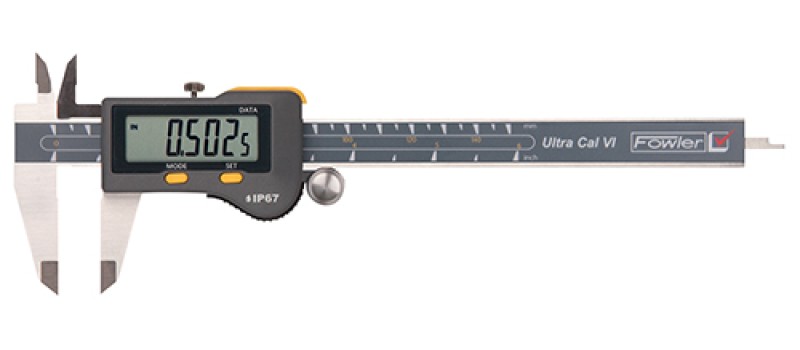At Gaging.com electronic gages now far outsell their analog/vernier counterparts. From time to time we still hear the old timers opine about how great their old school gages are but there is no denying the accuracy, speed and ease of use of a modern digital gage. Digital micrometers, Digital Calipers, Digital Bore Gages, Digital Levels, they are all here to stay but they did have a modest start. The first generation of digital gages had very little protection when it came to environmental or shop contaminates.
Capacitive based gages were among the first types of electronic hand tools to emerge. There were others before it, like the rotary encoder system which is still in use today but for the purpose of this blog, we will focus on capacitive systems and beyond. Capacitive based systems have an Achilles heel, liquids. The electronics of the gage can be protected with gaskets and a waterproof cover but a drop of liquid (water, oil, sweat) on the measuring scale itself will cause a miscount. The successor to the capacitive system is the inductive system. Its development ensured that digital gages were impervious to liquids on the scale as well as having the electronics protected. Even the connection of an spc data collection cable on higher-end systems communicate without an actual wired contact between the gage and connector itself, further enhancing protection when data output is needed.
Liquids are not the only culprit in the workshop however, often times fine metal grindings and dust can make their way into electronic packs and wreak havoc with the measuring system. Most standard covers provide decent protection against solids but just as sand makes its way into all your belongings (and car) at the beach, these particles have a way of getting into places they should not be. Ultimately, better protection was needed there as well.
There are many levels of protection that a customer can choose for their digital gages so it is important to be able to standardize the products so the end user knows what they are buying. Hence the use of the Ingress Protection Table or IP Code table. This table was developed by CENELEC and published by the IEC similarly by NEMA and ANSI
Solid particle protection
Level | Object size protected against | Effective against |
0 | -- | No protection against contact and ingress of objects |
1 | >50 mm | Any large surface of the body, such as the back of a hand, but no protection against deliberate contact with a body part |
2 | >12.5 mm | Fingers or similar objects |
3 | >2.5 mm | Tools, thick wires, etc. |
4 | >1 mm | Most wires, screws, etc. |
5 | Dust protected | Ingress of dust is not entirely prevented, but it must not enter in sufficient quantity to interfere with the satisfactory operation of the equipment; complete protection against contact |
6 | Dust tight | No ingress of dust; complete protection against contact |
Liquid ingress protection
| Level | Protected against | Testing for | Details |
| 0 | Not protected | — | — |
| 1 | Dripping water | Dripping water (vertically falling drops) shall have no harmful effect. | Test duration: 10 minutes Water equivalent to 1 mm rainfall per minute |
| 2 | Dripping water when tilted up to 15° | Vertically dripping water shall have no harmful effect when the enclosure is tilted at an angle up to 15° from its normal position. | Test duration: 10 minutes Water equivalent to 3 mm rainfall per minute |
| 3 | Spraying water | Water falling as a spray at any angle up to 60° from the vertical shall have no harmful effect. | Test duration: 5 minutes Water volume: 0.7 litres per minute |
| 4 | Splashing water | Water splashing against the enclosure from any direction shall have no harmful effect. | Test duration: 5 minutes Water volume: 10 litres per minute |
| 5 | Water jets | Water projected by a nozzle (6.3 mm) against enclosure from any direction shall have no harmful effects. | Test duration: at least 3 minutes Water volume: 12.5 litres per minute |
| 6 | Powerful water jets | Water projected in powerful jets (12.5 mm nozzle) against the enclosure from any direction shall have no harmful effects. | Test duration: at least 3 minutes Water volume: 100 litres per minute |
| 7 | Immersion up to 1 m | Ingress of water in harmful quantity shall not be possible when the enclosure is immersed in water under defined conditions of pressure and time (up to 1 m of submersion). | Test duration: 30 minutes Immersion at depth of at least 1 m measured at bottom of device, and at least 15 cm measured at top of device |
| 8 | Immersion beyond 1 m | The equipment is suitable for continuous immersion in water under conditions which shall be specified by the manufacturer. Normally, this will mean that the equipment is hermetically sealed. However, with certain types of equipment, it can mean that water can enter but only in such a manner that it produces no harmful effects. | Test duration: continuous immersion in water Depth specified by manufacturer |
So the IP67 caliper is dust tight with water immersion capability up to 1m! Pretty simple actually!
As always, if you have any further questions on gage IP ratings or any metrology questions in general please let us know. We love talking metrology with our customers!


Comments